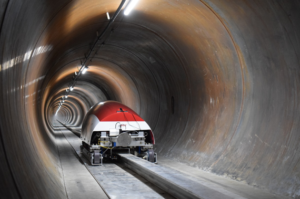 Elon Musik, who is founder and co-founder of several innovative companies including Tesla, has inaugurated the Hyperloop project with one of his companies, SpaceX. Although SpaceX was originally set up to explore aerospace manufacture and transport, with the ultimate goal of enabling colonisation of other planets, Musk recognised that harnessing the expertise of aeronautical engineers could revolutionise ground transport, and so set up Hyperloop.
Elon Musik, who is founder and co-founder of several innovative companies including Tesla, has inaugurated the Hyperloop project with one of his companies, SpaceX. Although SpaceX was originally set up to explore aerospace manufacture and transport, with the ultimate goal of enabling colonisation of other planets, Musk recognised that harnessing the expertise of aeronautical engineers could revolutionise ground transport, and so set up Hyperloop.
The Hyperloop concept is being developed so that pods will travel at very high speeds along a tube, to provide an alternative to flying, rail transportation and driving, while also being safe, convenient and kinder to the environment in not using power that is dependent on fossil fuels. There are several Hyperloop sites being established around the world, and in 2015 Musk launched a competition to encourage the best international student groups to push the boundaries of science and create their ideas of how pods could operate.
Two such top universities – Massachusetts Institute of Technology (MIT in the US) and Delft University of Technology (TU Delft, in the Netherlands) – took part in the first phase of a competition in January this year to unveil their prototype pods at a Hyperloop test track in California. Challenged with a tunnel of one mile in length and six-feet diameter, the teams had to demonstrate that their pods could safely accelerate to speeds of up to 250 mph and break to a standstill without crashing. Both teams used magnetic levitation as their method of propulsion.
The future of transport innovation
Max Opgenoord, a PhD student who is researching transonic aeroelasticity (the interaction between the aerodynamics and the structural dynamics of aircraft) was the project leader for the MIT Hyperloop team. “It has been an exciting ride,” he says. “When we started with the competition, no one knew what a Hyperloop pod should look like, so we had incredible design freedom. And now, almost two years later, we have demonstrated that a Hyperloop pod can be built. The levitation was definitely the most challenging part of the project, because there were so many options.”
Max Opgenoord, a PhD student who is researching transonic aeroelasticity (the interaction between the aerodynamics and the structural dynamics of aircraft) was the project leader for the MIT Hyperloop team. “It has been an exciting ride,” he says. “When we started with the competition, no one knew what a Hyperloop pod should look like, so we had incredible design freedom. And now, almost two years later, we have demonstrated that a Hyperloop pod can be built. The levitation was definitely the most challenging part of the project, because there were so many options.”
As part of the competition, the rules stipulated that participants from different study areas such as engineering, technology, manufacturing, and business management should work together. Musk realised that in order for innovative ideas to become a realistic proposition for high-speed, low-carbon and scalable mass transit, a practical all-round approach would be needed. Edouard Schneiders, an applied physics student was on the team for TU Delft’s competition entry. “It was very exciting to take part in this competition – the atmosphere was ecstatic,” he says. “Hyperloop is extremely fast and extremely efficient. It will have enormous social and economic consequences whilst vastly reducing emissions. “Transportation has not significantly progressed since the release of the Boeing 747 and the invention of MagLev trains in 1970. The transportation industry needs to evolve and look for completely new solutions like Hyperloop in order to make a real impact.”
Experts from SpaceX and Tesla, along with university professors, judged the competititon entries. The TU Delft Hyperloop team won first prize overall, while MIT Hyperloop won an award for safety and reliability.



